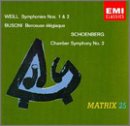| All Artists: Kurt Weill, Ferruccio Busoni, Arnold Schoenberg, Frederik Prausnitz, Gary Bertini, BBC Symphony Orchestra, New Philharmonia Orchestra Title: Kurt Weill, Ferruccio Busoni and Arnold Schoenberg: Matrix 25 Members Wishing: 0 Total Copies: 0 Label: Capitol Release Date: 2/13/1996 Genre: Classical Styles: Forms & Genres, Theatrical, Incidental & Program Music, Historical Periods, Modern, 20th, & 21st Century, Symphonies Number of Discs: 1 SwapaCD Credits: 1 UPC: 724356586925 |
Search - Kurt Weill, Ferruccio Busoni, Arnold Schoenberg :: Kurt Weill, Ferruccio Busoni and Arnold Schoenberg: Matrix 25
 | Kurt Weill, Ferruccio Busoni, Arnold Schoenberg Kurt Weill, Ferruccio Busoni and Arnold Schoenberg: Matrix 25 Genre: Classical |
Larger Image |
CD Details |
CD ReviewsFine Performances Of Rarely-Heard Modernist Works Jeffrey Lipscomb | Sacramento, CA United States | 06/08/2005 (5 out of 5 stars) "The first track of this excellently-transferred CD would make a great "guess the composer" item for your fellow classical music buffs. Frankly, I would never guess the composer's identity. It's the single movement First Symphony (1921) by Kurt Weill (1900-1950), a singularly gloomy work that is a weird bridge between late Romantic and early expressionistic styles. Apparently Weill's teacher Ferrucio Busoni loathed the piece and urged his pupil to destroy it. This is followed by Weill's beautiful 2nd Symphony (1934), much of which sounds style-wise like his 1920's masterpiece "The Three Penny Opera." It shares with the latter a rather tart, satirical mode (but the 2nd mvt. also has a gorgeous lyrical theme). EMI's transfer of Weill's two symphonies is sonically a fine match for the original Argo LP that I bought back in the 1970's. The only other recording of this symphonic pair that I have heard is the Edo de Waart (Philips). To my ears Bertini and de Waart battle to a draw in the 1st, while I distinctly prefer Bertini's better combination of warmth and drama in #2. The latter is, to my mind, one of the most neglected of the 20th century's minor orchestral masterpieces, and I warmly recommend this excellent Bertini interpretation. The remaining two works on this CD are conducted by Frederik Prausnitz with the New Philharmonia Orchestra. The Berceuse Elegiaque (1909) by Busoni (1866-1924) is an orchestral extension of a piano work composed two years earlier and was occasioned by the death of the composer's mother. Ironically, it was premiered in February 1911 by Gustav Mahler before his death the following May. It is one of Busoni's finest works, and was later championed by Toscanini. Busoni was one of the great musical teachers: his pupils included Kurt Weill, Joseph Szigeti and Dmitri Mitropoulos. Arnold Schoenberg (1874-1951) began work on his Chamber Symphony #2 in 1906 on the same day he completed his Chamber Symphony #1 (the latter can be heard in a fine performance by Hermann Scherchen on a Tahra CD), but its completion took many years. In 1916 the elegaic first mvt. was completed, but the remainder took another 23 years to finish. By then Schoenberg had finalized his 12-tone technique, but his return to this neo-tonal work was occasioned by his escape from Germany and the need to offset the severity of his dodecaphonic compositions with something more traditional. Its closing 2nd mvt. is in a dark Mahlerish vein and ends in an atmosphere of despondency (pretty much unique in Schoenberg's oeuvre). Like Weill's 2nd Symphony, its bleak final pages no doubt reflect the grim prospects of impending global war. This is one of Schoenberg's most accessible and rewarding works, and the performance by Prausnitz is superb. Highly recommended. Jeff Lipscomb" Weill's incredible 1st sym/great performance paul best | new orleans | 04/08/2006 (5 out of 5 stars) "Weill's 1st sym has passages that grip me every time I hear this sym. Never tire of it's emotive elements. Some might say it has influences of Mahler.
That might be, but I don't care much for Mahler. In contrast to my dis-interest in Mahler, this Weill sym captivates me to ne end. I have 4 recordings. This one, which may be my fav. and is OOP Roland Baden/Kracow/Koch which is OOP< maybe my second fav, but is also OOP Swierczewski/Gulbenkian/Nimbus/my 3rd fav, and is still in print. Then the new release from Naxos, Alsop/Bournemouth, my 4th copy. Weill's 2nd sym has not proved as successful as his 1st, but I'm still working with it. Then of course there is the Schonberg 2nd Chamber, which is a bonus track. But the star of the show here is the Weill 1st. An astonishing work that remains unknown yet a real jewel. " |
